Day 1 (May 10th) Flight Out of Little Rock
FLIGHT TIMES
1:40 depart Little Rock
3:25 arrive in Chicago
5:30 depart Chicago
8:45 arrive in Paris
Day 2 (May 11th) PARIS

THE HISTORY OF PARIS
The earliest archaeological signs of permanent habitation in the Paris area date from around 4200 BC. The Parisii, a sub-tribe of the Celtic Sennoes, inhabited the area near the river Seine from around 250 BC. The Romans conquered the Paris basin in 52 BC, with a permanent settlement by the end of the same century on the Left Bank Sainte Genevieve Hill adn the Ile de la Cite. The Gallo-Roman town was originally called Lutetia, but later Gallicised to Lutèce. It expanded greatly over the following centuries, becoming a prosperous city with a forum, palaces, baths, temples, theatres, and an amphitheatre. The collapse of the Roman empire and the fifth-century Germanic invasions sent the city into a period of decline. By 400 AD, Lutèce, by then largely abandoned by its inhabitants, was little more than a garrison town entrenched into the hastily fortified central island. The city reclaimed its original appellation of "Paris" towards the end of the Roman occupation. The Frankish king Clovis I established Paris as his capital in 508.
Paris' population was around 200,000 when the Black Death arrived in 1348, killing as many as 800 people a day, and 40,000 died from the plague in 1466. Paris lost its position as seat of the French realm during occupation of the English-allied Burgundians during the Hundred Years' War, but regained its title when Charles VII of France reclaimed the city from English rule in 1436. Paris from then became France's capital once again in title, but France's real centre of power would remain in the Loire Valley until King François I returned France's crown residences to Paris in 1528. During the French Wars of Religion, Paris was a stronghold of the Catholic party. In August 1572, under the reign of Charles IX, while many noble Protestants were in Paris on the occasion of the marriage of Henry of Navarre, the future Henry IV, to Marguerite de Valois, sister of Charles IX, the St. Bartholomew's Day massacre occurred; begun on 24 August, it lasted several days and spread throughout the country. During the Fronde, Parisians rose in rebellion and the royal family fled the city (1648). King Louis XIV then moved the royal court permanently to Versailles in 1682. A century later, Paris was the centre stage for the French Revolution, with the Storming of the Bastille on 14 July 1789 and the overthrow of the monarchy in September 1792.
Click on sights to learn more about them:
The Arc de Triomphe
Eiffel Tower
Musee du Louvre
Musee d' Orsay
Notre-Dame
Pantheon
Les Invalides
Chateau de Versailles
THE AGENDA:
(Subject to change)
1. Arrive in Paris around 8:00 am
2. Take Train to Paris Central and Unload Luggage at Hotel
3. Tour the Eiffel Tower
4. Lunch
5. Tour the Arc de Triomphe
6. Tour Notre-Dame
7. Visit Les Invalides
8. Dinner
9. Settle down for the night
THE ARC DE TRIOMPHE
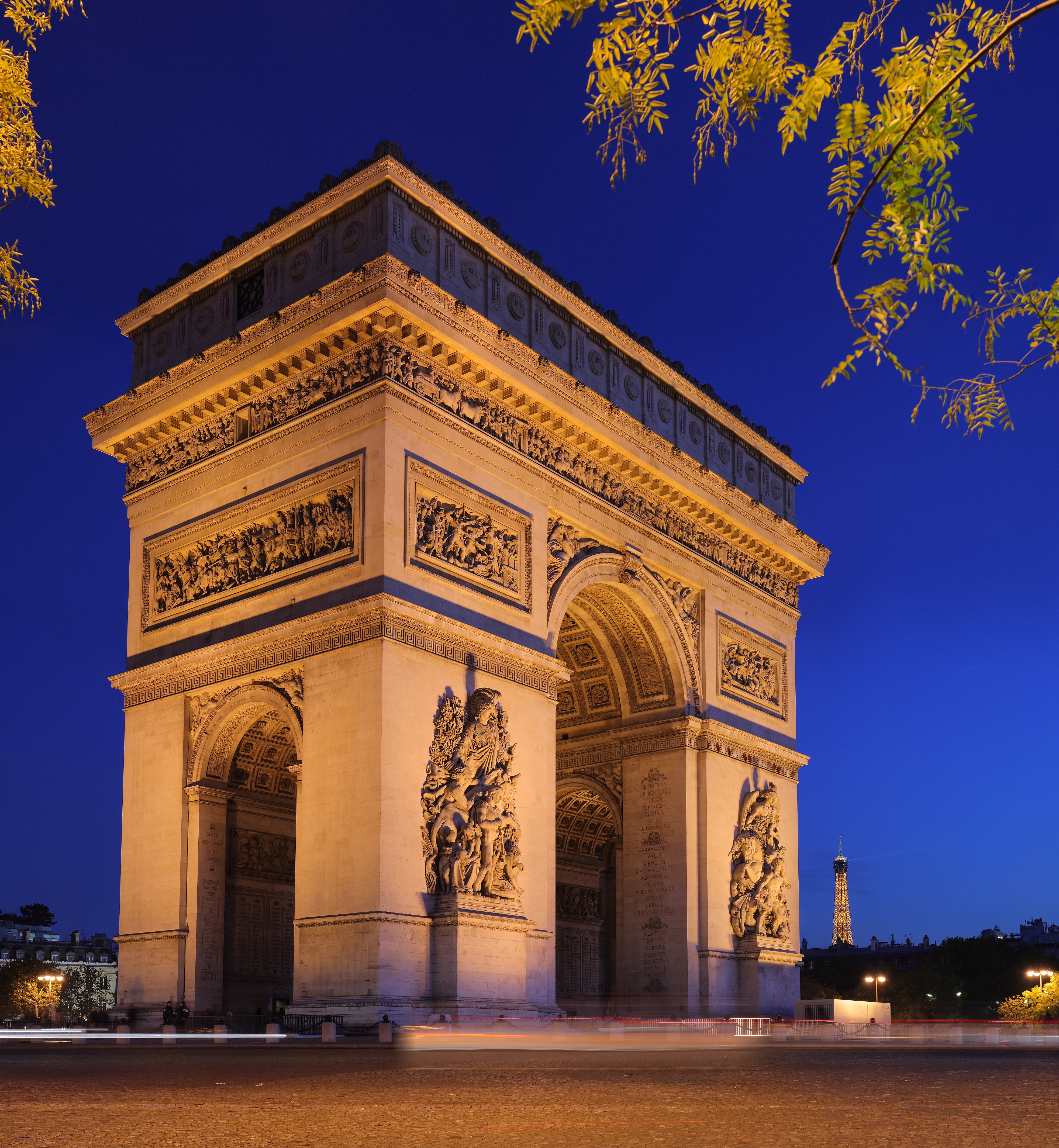 The Arc de Triomphe is a monument in Pairs, France that stands in the centre of the Place Charles de Gaulle, also known as the "Place de l'Étoile". It is at the western end of the Champs-Élysées. The triumphal honors those who fought for France, particularly during the Napoleonic Wars. On the inside and the top of the arc there are all of the names of generals and wars fought. Underneath is the tomb of the unknown soldier from World War I . The Arc is the linchpin of the historic axis (L'Axe historique) — a sequence of monuments and grand thoroughfares on a route which goes from the courtyard of the Louvre Palace to the outskirts of Paris. The monument was designed by Jean Chalgrin in 1806, and its icongrapic program pitted heroically nude French youths against bearded Germanic warriors in chain mail and set the tone for public monuments, with triumphant nationalistic messages, until World War I. The monument stands 49.5 m (162 ft) in height, 45 m (150 ft) wide and 22 m (72 ft) deep. The large vault is 29.19 m (95.8 ft) high and 14.62 m (48.0 ft) wide. The small vault is 18.68 m (61.3 ft) high and 8.44 m (27.7 ft) wide. It is the second largest triumphal arch in existence. Its design was inspired by the Roman Arch of Titus. The Arc de Triomphe is so colossal that three weeks after the Paris victory parade in 1919, marking the end of hostilities in World War I, Charles Godefroy flew his Nieuport biplane through it, with the event captured on newsreel.
The Arc de Triomphe is a monument in Pairs, France that stands in the centre of the Place Charles de Gaulle, also known as the "Place de l'Étoile". It is at the western end of the Champs-Élysées. The triumphal honors those who fought for France, particularly during the Napoleonic Wars. On the inside and the top of the arc there are all of the names of generals and wars fought. Underneath is the tomb of the unknown soldier from World War I . The Arc is the linchpin of the historic axis (L'Axe historique) — a sequence of monuments and grand thoroughfares on a route which goes from the courtyard of the Louvre Palace to the outskirts of Paris. The monument was designed by Jean Chalgrin in 1806, and its icongrapic program pitted heroically nude French youths against bearded Germanic warriors in chain mail and set the tone for public monuments, with triumphant nationalistic messages, until World War I. The monument stands 49.5 m (162 ft) in height, 45 m (150 ft) wide and 22 m (72 ft) deep. The large vault is 29.19 m (95.8 ft) high and 14.62 m (48.0 ft) wide. The small vault is 18.68 m (61.3 ft) high and 8.44 m (27.7 ft) wide. It is the second largest triumphal arch in existence. Its design was inspired by the Roman Arch of Titus. The Arc de Triomphe is so colossal that three weeks after the Paris victory parade in 1919, marking the end of hostilities in World War I, Charles Godefroy flew his Nieuport biplane through it, with the event captured on newsreel.NOTRE-DAME
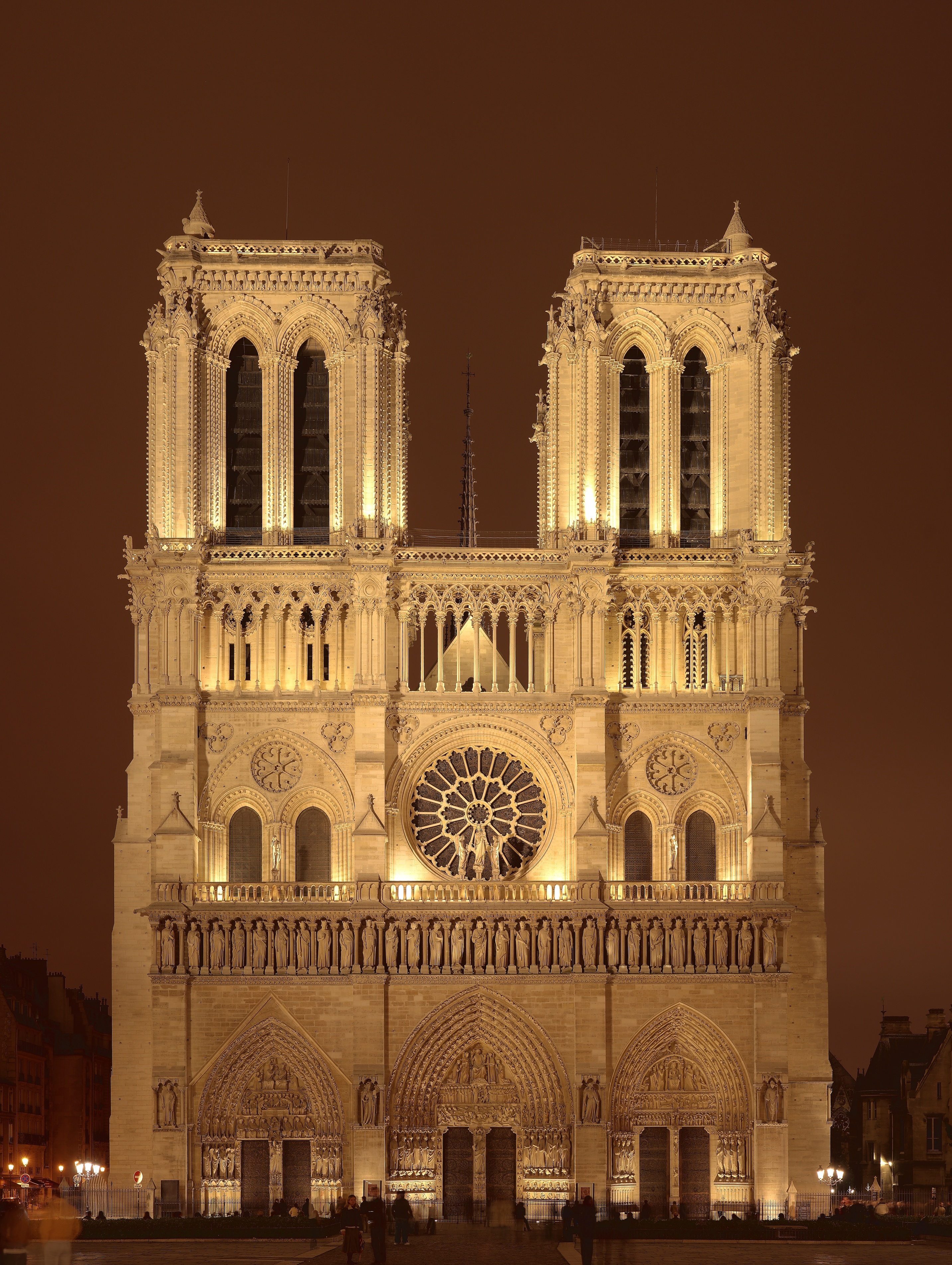
In 1160, because the church in Paris had become the "parish church of the kings of Europe", Bishop Maurice de Sully deemed the previous Parisian cathedral, St Stephen's (which had been founded in the 4th century) unworthy of its lofty role, and had it demolished shortly after he assumed the title of Bishop of Paris. As with most foundation myths, this account needs to be taken with a grain of salt; archeological excavations in the 20th century suggested that the Merovingian Cathedral replaced by de Sully was itself a massive structure, with a five-aisled nave and a facade some 36m across. It seems likely therefore that the faults with the previous structure were exaggerated by the Bishop to help justify the rebuilding in a newer style. According to legend, de Sully had a vision of a glorious new cathedral for Paris, and sketched it on the ground outside the original church. To begin the construction, the bishop had several houses demolished and had a new road built in order to transport materials for the rest of the cathedral. Construction began in 1163, during the reign of Louis VII, and opinion differs as to whether Maurice de Sully or Pope Alexander III laid the foundation stone of the cathedral. However, both were at the ceremony in question. Bishop de Sully went on to devote most of his life and wealth to the cathedral's construction. Construction of the choir took from 1163 until around 1177 and the new High Altar was consecrated in 1182 (it was normal practice for the eastern end of a new church to be completed first, so that a temporary wall could be erected at the west of the choir, allowing the chapter to use it without interruption while the rest of the building slowly took shape). After Bishop Maurice de Sully's death in 1196, his successor, Eudes de Sully (no relation) oversaw the completion of the transepts and pressed ahead with the nave, which was nearing completion at the time of his own death in 1208. By this stage, the western facade had also been laid out, though it was not completed until around the mid 1240s. Over the construction period, numerous architects worked on the site, as is evidenced by the differing styles at different heights of the west front and towers. Between 1210 and 1220, the fourth architect oversaw the construction of the level with the rose window and the great halls beneath the towers. The most signifiant change in design came in the mid 13th century, when the transepts were remodelled in the latest Rayonnant style; in the late 1240s Jean de Chelles added a gabled portal to the North transept topped off by a spectacular rose window. Shortly afterwards (from 1258) Pierre de Montreuil executed a similar scheme on the South transept. Both these transept portals were richly embellished with sculpture; the south portal features scenes from the lives of St Stephen and of various local saints, while the north portal featured the infancy of Christ and the story of Theophilus in the tympanum, with a highly influential statue of the Virgin and Child in the trumeau. The cathedral was effectively complete by around 1345.
HOTEL
Grand Hotel Leveque
Day 3 (May 12th) PARIS
AGENDA:
1. Breakfast
2. Tour the Louvre
4. Lunch
5. Visit the Palace of Versalles
6. Dinner
7. A night viewing of the Eiffel Tower for those interested
The Louvre is the largest museum in the world (over 6 miles of exhibits), and is also considered as the best art gallery in the world. It is not possible to see everything in the Louvre. Therefore it is best to provide a time limit (around 3 hours o
 r so) and allow each person in our group to tour at their own pleasure. Different people will find different things interesting. For those who want to stick with me, I will try to hit the more notable exhibits; kind of a general tour of the best of the Louvre. I recommend that you visit the Louvre's website and spend awhile getting familiar with its various collections (this is a great website). The Louvre can be broken down into 6 sections. Egyptian Antiquities, Oriental Antiquities and Islamic Art, Greek and Roman Antiquities, French Painting, Northern European Painting, Italian and Spanish Painting, Sculpture, and Objects d'Art.
r so) and allow each person in our group to tour at their own pleasure. Different people will find different things interesting. For those who want to stick with me, I will try to hit the more notable exhibits; kind of a general tour of the best of the Louvre. I recommend that you visit the Louvre's website and spend awhile getting familiar with its various collections (this is a great website). The Louvre can be broken down into 6 sections. Egyptian Antiquities, Oriental Antiquities and Islamic Art, Greek and Roman Antiquities, French Painting, Northern European Painting, Italian and Spanish Painting, Sculpture, and Objects d'Art.Here are some of the more notable exhibits of each collections (at least exhibits I find interesting) . Click on the underline words to learn more.
A. EGYPTIAN ANTIQUITIES:
1. The Large Sphinx (Old Kingdom c. 2600 B.C.)
2. Sarcophagus of King Rames III (1184-1153 B.C.)
B. ORIENTAL ANTIQUITIES AND ISLAMIC ART:
1. The Law of Hammurabi
2. Walking Lion (6th century B.C., from the Temple Of Ishtar, Babylon)
3. King Sargon II and a Dignitary (713-704 B.C., from the palace of King Sargon II)
4. Winged Bull (713-705 B.C., from the palace of King Sargon II)
5. Frieze of Archers (510 B.C., from the reign of Darius I)
C. GREEK AND ROMAN ANTIQUITIES:
1. Aphrodite, known as Venus de Milo (c. 100 B.C., Greece)
2. Portrait of Socrates (330 B.C.)
3. Hadrian (2d century A.D.)
4. The Winged Victory of Samothrace (c. 190 B.C.)
D. FRENCH PAINTING:
1. Christ with St. Joseph by George de La Tour (1652)
2. Louis XIV by Hyacinth Rigauy Ros (1701)
3. The Coronation of Napolean by Jacques-Louis David (1806-7)
4. Liberty Leading the People by Eugene Delacroix (1830)
E. NORTHERN EUROPEAN PAINTING:
1. Erasmus by Hans Holbein the Younger (1497)
2. The Tower of Babel by Lucas van Valchenborch (1597)
3. Jester with a Lute by Frans Hals (1666)
4. Self-Portrait by Rembrandt (1633)
F. ITALIAN AND SPANISH PAINTING:
1. Christ Blessing by Bellini (1516)
2. Mona Lisa by Leonardo de Vinci (1519)
3. The Supper at Emmaus by Titian (1535)
4. The Fortune Teller by Michelangelo (1571)
5. The Club-Footed Boy by Jusepe de Ribera (1642)
G. SCULPTURE:
1. Charles V. King of France (1365-80)
2. Voltaire by Jean-Baptiste Pigalle (1785)
3. Virgin and Child by Donatello (1466)
THE PALACE OF VERSALLES
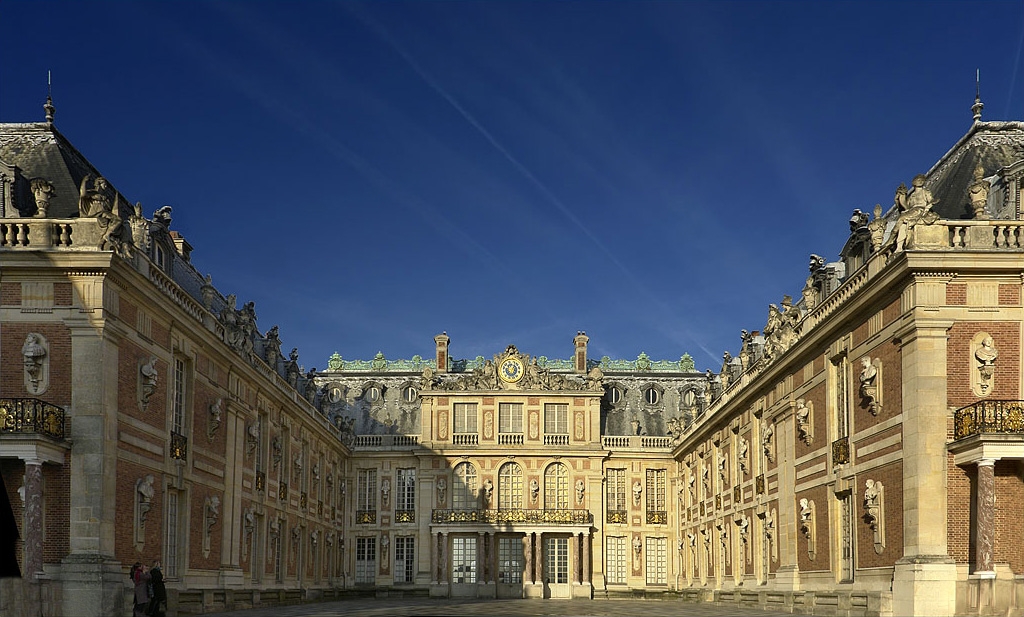 When the château was built, Versailles was a country village; today, however, it is a suburb of Paris, some twenty kilometers southwest of the French capital. The court of Versailles was the center of political power in France from 1682, when Louis XIV moved from Paris, until the royal family was forced to return to the capital in October 1789 after the beginning of French Revolution. Versailles is therefore famous not only as a building, but as a symbol of the system of absolute monarchy of the Ancien Régime. For more information upon the Versailles click here.
When the château was built, Versailles was a country village; today, however, it is a suburb of Paris, some twenty kilometers southwest of the French capital. The court of Versailles was the center of political power in France from 1682, when Louis XIV moved from Paris, until the royal family was forced to return to the capital in October 1789 after the beginning of French Revolution. Versailles is therefore famous not only as a building, but as a symbol of the system of absolute monarchy of the Ancien Régime. For more information upon the Versailles click here.NIGHT VIEWING OF THE EIFFEL TOWER

HOTEL
Hotel Grand Leveque
Day 4 (May 13th) Provence -- Arles & Nimes
AGENDA:
1. Take the 7:46 am TGV train out of Paris and arrive at Nîmes
2. Check into hotel
3. Take train to Aries
6. Tour the sights in Aries
7. Take train to Avignon
8. Tour the Popes Palace
9. Take train back to Nimes
The TGV train from Paris to Nimes
ARLES

The Main Sights in Arles
- The Roman theater
- The arena or amphitheater
- The Alyscamps (Roman necropolis)
- The Thermae of Constantine
- The cryptoporticus
- The obelisk
Cafe Terrace at Night by Vincent Van Gogh (September 1888). It depicts the warmth of a café in Arles.
Arènes d'Arles
 Arles was established by the Romans. The Romans took the town in 123 BC and expanded it into an important city, with a canal link to the Mediterranean Sea being constructed in 104 BC. However, it struggled to escape the shadow of Marseilla further along the coast.
Arles was established by the Romans. The Romans took the town in 123 BC and expanded it into an important city, with a canal link to the Mediterranean Sea being constructed in 104 BC. However, it struggled to escape the shadow of Marseilla further along the coast. Its chance came when it sided with Julius Caesar against Pompey, providing military support. Massalia backed Pompey; when Caesar emerged victorious, Massalia was stripped of its possessions, which were transferred to Arelate as a reward. The town was formally established as a colony for veterans of the Roman legion Legi VI Ferrata, which had its base there. Its full title as a colony was Colonia Iulia Paterna Arelatensium Sextanorum, "the ancestral Julian colony of Arles of the soldiers of the Sixth."
The Roman Theatre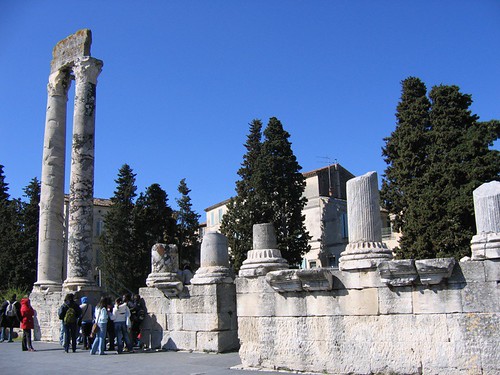 The characteristics of Roman theatres are similar to those of the earlier Greek theatres due in large part to its influence on a single Roman Consul or emperor, Gnaeus Pompeius Magnus. Much of the architectural influence on the Romans came from the Greeks, and theatre structural design was no different from other buildings. However, Roman theatres have specific differences, such as being built upon their own foundations instead of earthen works or a hillside and being completely enclosed on all sides. Roman theatres derive their basic design from the Theatre of Pompey, the first permanent Roman theatre.
The characteristics of Roman theatres are similar to those of the earlier Greek theatres due in large part to its influence on a single Roman Consul or emperor, Gnaeus Pompeius Magnus. Much of the architectural influence on the Romans came from the Greeks, and theatre structural design was no different from other buildings. However, Roman theatres have specific differences, such as being built upon their own foundations instead of earthen works or a hillside and being completely enclosed on all sides. Roman theatres derive their basic design from the Theatre of Pompey, the first permanent Roman theatre.The Oblisk
 The obelisk was first erected under the Roman emperor Constantine II in the center of the spina of the Roman circus of Arles. After the circus was abandoned in the 6th century, the obelisk fell down and was broken in two parts. It was rediscovered in 1389. Its re-erection in its current location was completed on March 26, 1676, on top of a pedestal designed by Arlesian architect Jacques Peytret. A fountain was added at its base during the 19th century, together with bronze sculptures by Antoine Laurent Dantan.
The obelisk was first erected under the Roman emperor Constantine II in the center of the spina of the Roman circus of Arles. After the circus was abandoned in the 6th century, the obelisk fell down and was broken in two parts. It was rediscovered in 1389. Its re-erection in its current location was completed on March 26, 1676, on top of a pedestal designed by Arlesian architect Jacques Peytret. A fountain was added at its base during the 19th century, together with bronze sculptures by Antoine Laurent Dantan.AVIGNON
Popes' Palace (Palais des Papes)
 Avignon became the residence of the Popes in 1309, when the Gascon Bertrand de Goth, as Pope Clement V, unwilling to face the violent chaos of Rome after his election (1305), moved the Papal Curia to Avignon, a period known as the Avignon Papacy. Clement lived as a guest in the Dominican monastery at Avignon, and his successor Pople John XXII set up a magnificent establishment there, but the reconstruction of the old bishops' palace was begun in earnest by Pope Benedict XII (1334-42) and continued by his successors to 1364. The site, on a natural rocky outcrop at the northern edge of Avignon, overlooking the river Rhone, was that of the old episcopal palace of the bishops of Avignon. The Palais was built in two principal phases with two distinct segments, known as the Palais Vieux (Old Palace) and Palais Neuf (New Palace). By the time of its completion, it occupied an area of 11,000 m² (2.6 acres). The building was enormously expensive, consuming much of the papacy's income during its construction.
Avignon became the residence of the Popes in 1309, when the Gascon Bertrand de Goth, as Pope Clement V, unwilling to face the violent chaos of Rome after his election (1305), moved the Papal Curia to Avignon, a period known as the Avignon Papacy. Clement lived as a guest in the Dominican monastery at Avignon, and his successor Pople John XXII set up a magnificent establishment there, but the reconstruction of the old bishops' palace was begun in earnest by Pope Benedict XII (1334-42) and continued by his successors to 1364. The site, on a natural rocky outcrop at the northern edge of Avignon, overlooking the river Rhone, was that of the old episcopal palace of the bishops of Avignon. The Palais was built in two principal phases with two distinct segments, known as the Palais Vieux (Old Palace) and Palais Neuf (New Palace). By the time of its completion, it occupied an area of 11,000 m² (2.6 acres). The building was enormously expensive, consuming much of the papacy's income during its construction.NIMES
The Main Sights in Nimes
Nîmes may have been one of the richest and finest Roman cities of Gaul.
- The Maison Carrée
- The Arena of Nîmes
Maison Carrée
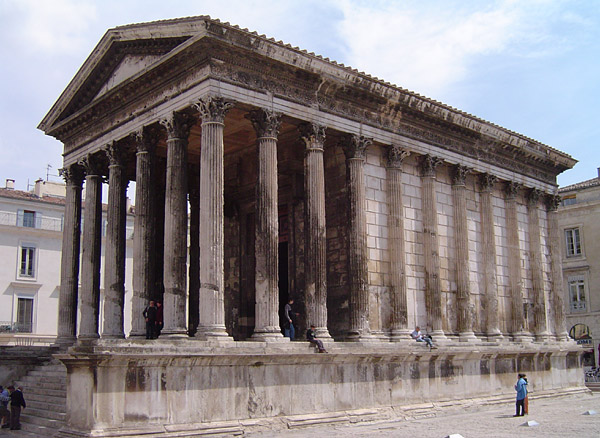
The Maison Carrée is an ancient building in Nimes; it is one of the best preserved temples to be found anywhere in the territory of the former Roman Empire. It was built c. 16 BC, and reconstructed in the following years, by Marcus Vipsanius Agrippa, who was also the original patron of the Pantheon in Rome, and was dedicated or rededicated c. 2-4/5 AD to his two sons, Gaius Julius Caesar and Lucius Caesar, adopted heirs of Augustus who both died young. The inscription dedicating the temple to Gaius and Lucius was removed in medieval times. However, a local scholar, Jean-François Séguier, was able to reconstruct the inscription in 1758 from the order and number of the holes in the portico's facade, to which the bronze letters had been affixed by projecting tines. According to Séguier's reconstruction, the text of the dedication read (in translation): "To Gaius Caesar, son of Augustus, Consul; to Lucius Caesar, son of Augustus, Consul designate; to the princes of youth." The temple owes its preservation to the fact that it was rededicated as a Christian church in the fourth century, saving it from the widespread destruction of temples that followed the adoption of Christianity as Rome's official state religion. It subsequently became a meeting hall for the city's consuls, a canon's house, a stable for government-owned horses during the French Revolution and a storehouse for the city archives. It became a museum after 1823. Its French name derives from the archaic term carré long, literally meaning a "long square", or rectangle - a reference to the building's shape.
The Arena of Nîmes
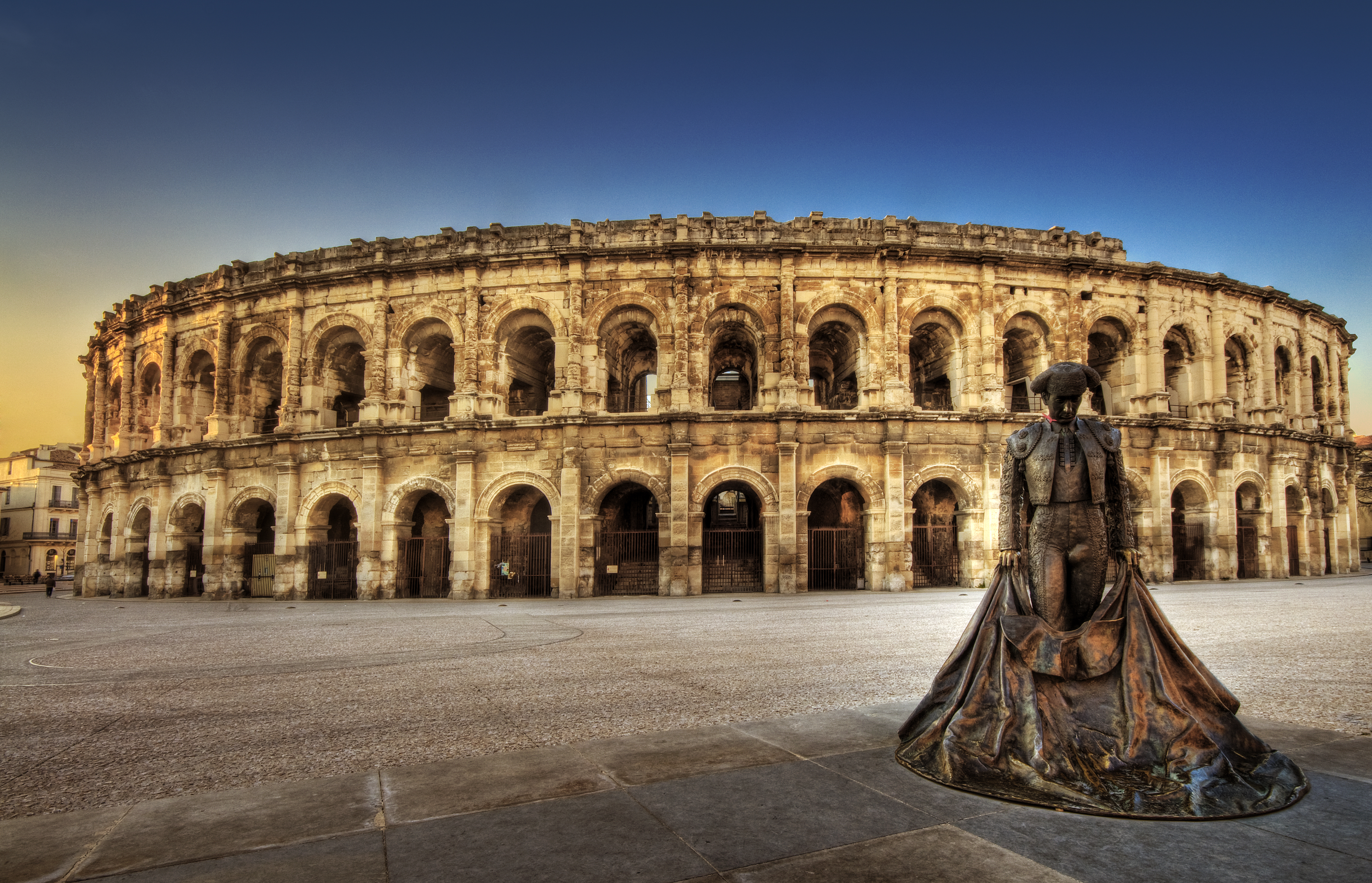 The elliptical Roman amphitheatre, of the first or second century AD, is the best-preserved Roman arena in France. It was filled with medieval housing, when its walls served as ramparts, but they were cleared under Napoleon. It is still used today as a bull fighting and concert arena.
The elliptical Roman amphitheatre, of the first or second century AD, is the best-preserved Roman arena in France. It was filled with medieval housing, when its walls served as ramparts, but they were cleared under Napoleon. It is still used today as a bull fighting and concert arena.HOTEL:
Hotel de Provence
Day 5 (May 14th) Provence -- Les Baux & Pont du Gard
AGENDA:
1. Breakfast
2. Travel to Les Baux
4. Tour Les Baux
5. Lunch
6. Travel to Point du Gard
8. Back to Nimes
9. Dinner
Les Baux, a strong-hold for the French Huguenots

The defensive possibilities of Les Baux led to the site being settled early on in human history. Traces of habitation have been found dating back as far as 6000 BC, and the site was used by the Celts as a hill fort or oppidum around the 2nd century BC. During the Middle Ages it became the seat of a powerful feudal lordship that controlled 79 towns and villages in the vicinity. The lords of Baux sought control of Provence for many years. They claimed ancestry from the Magus king Balthazar and placed the Star of Belthehem on their coat of arms. The knights of Les Baux use a scent derived from Cypress trees before battle to give them courage, as the symbol of Les Baux is the Cypress tree. L'Occitane En Provence make a [men's range] in this scent (Cypress, Frankincense and Vanilla) as a way of preserving the culture. Despite their strengths, the lords of Baux were deposed in the 12th century. However, the great castle at Les Baux became renowned for its court, famed for a high level of ornateness, culture and chivarlry. The domain was finally extinguished in the 15th century with the death of the last princess of Baux, Alice of Baux. Les Baux was later joined, along with Provence, to the French crown under the governance of the Manville family. It became a centre for Protestantism and its unsuccessful revolt against the crown, led Cardinal Richelieu in 1632 to order that the castle and its walls should be demolished. Les Baux is now given over entirely to the tourist trade, relying on a reputation as one of the most picturesque villages in France.


(Check out these great websites: www.lesbauxdeprovence.com and www.provenceweb.fr)
Pont du Gard

It has long been thought that the Pont du Gard was built by Augustus' son-in-law and aide, Marcus Vipsanius Agrippa, around the year 19 BC. Newer excavations, however, suggest the construction may have taken place in the middle of the first century A.D; consequently, opinion is now somewhat divided on the matter. Designed to carry the water across the small Gardon river valley, it was part of a nearly 50 km (31 mi) aqueduct that brought water from the Fontaines d'Eure springs near Uzes to the Castellum in the Roman city of Nemausus (Nîmes). The full aqueduct had a gradient of 34 cm/km (1/3000), descending only 17 m vertically in its entire length and delivering 20,000 cubic meters (5 million gallons) of water daily. It was constructed entirely without the use of mortar. The aqueduct's stones – some of which weigh up to 6 tons – were precisely cut to fit perfectly together eliminating the need for mortar. The masonry was lifted into place by block and tackle with a massive human-powered treadmill providing the power for the winch. A complex scaffold was erected to support the aqueduct as it was being built. The face of the aqueduct still bears the mark of its construction, in the form of protruding scaffolding supports and ridges on the piers which supported the semicircular wooden frames on which the arches were constructed. Various inscriptions are found across the surface, containing instructions used in construction. For example, "FRS II" (frons sinistra II, Latin for "left face 2"), phallic symbols (intended to ward off bad luck), and graffiti left by builders throughout the ages. The upper levels of the bridge are slightly curved in the upstream directions, a fact long attributed to the engineers wanting to strengthen it against the flow of water, like a dam wall. However, a microtopgraphic survey carried out in 1989 showed that the bend is caused by the daily expansion and contraction of stones under the heat of the sun, by about 5 millimetres. Over the centuries, this process has produced the deformation witnessed now. It is believed to have taken about three years to build, employing between 800 and 1,000 workers.
HOTEL:
Day 6 (May 15th) Switzerland
AGENDA:
1, Take morning train to Geneva
2. Tour Geneva
3. View Chillon Castle
4. Take Golden Pass to Interlaken
5. Dinner
GENEVA

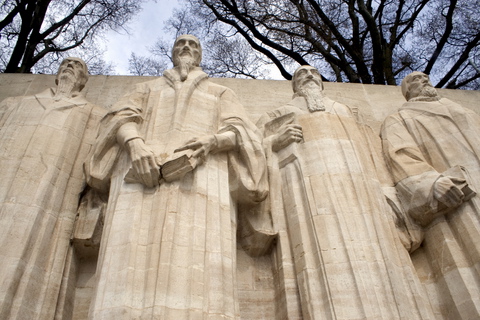 The Protestant Reformation affected Geneva. While Bern favoured the introduction of the new teaching and demanded liberty of preaching for the Reformers Guillaume Farel and Antone Froment, Catholic Fribourg renounced in 1511 its allegiance with Geneva. In 1532 the Roman Catholic bishop of the city was obliged to leave his residence, never to return. In 1536, the Genevans declared themselves Protestant and proclaimed their city a republic. The Protestant leader John Calvin was based in Geneva from 1536 to his death in 1564 (save for an exile from 1538 to 1541) and became the spiritual leader of the city. Geneva became a centre of Protestant activity, producing works such as the Genevevan Psalter, though there were often tensions between Calvin and the city's civil authorities. Though the city proper remained a Protestant stronghold under St. Francis de Sales, a large part of the historic diocese returned to Catholicism in the early seventeenth century.
The Protestant Reformation affected Geneva. While Bern favoured the introduction of the new teaching and demanded liberty of preaching for the Reformers Guillaume Farel and Antone Froment, Catholic Fribourg renounced in 1511 its allegiance with Geneva. In 1532 the Roman Catholic bishop of the city was obliged to leave his residence, never to return. In 1536, the Genevans declared themselves Protestant and proclaimed their city a republic. The Protestant leader John Calvin was based in Geneva from 1536 to his death in 1564 (save for an exile from 1538 to 1541) and became the spiritual leader of the city. Geneva became a centre of Protestant activity, producing works such as the Genevevan Psalter, though there were often tensions between Calvin and the city's civil authorities. Though the city proper remained a Protestant stronghold under St. Francis de Sales, a large part of the historic diocese returned to Catholicism in the early seventeenth century.
Plan of Geneva and environs in 1841. The colossal fortifications, among the most important in Europe, were demolished ten years later.
CHATEAU-DE-CHILLON

The Chillon Castle (Château de Chillon) is located on the shore of Lake Geneva in the municipality of Veytaux, at the eastern end of the lake, 3 km from Montreux, Switzerland. The castle consists of 100 independent buildings that were gradually connected to become the building as it stands now. The oldest parts of the castle have not been definitively dated, but the first written record of the castle is in 1160 or 1005. From the mid 12th century, the castle was home to the Counts of Savoy, and it was greatly expanded in the 13th century by Pietro II. The Castle was never taken in a siege, but did change hands through treaties. It was made popular by Lord Byron, who wrote the poem The Prisoner Of Chillon (1816) about Francois de Bonivard, a Genevois monk and politician who was imprisoned there from 1530 to 1536; Byron also carved his name on a pillar of the dungeon. The castle is one of the settings in Henry James' novella Daisy Miller (1878). The history of Chillon was influenced by 3 major periods: the Savoy Period, the Bernese Period and the Vaudois Period. Chillon now hosts a museum with some historical objects preserved and is open to public tours.


The golden pass is considered to be one of the most scenic train rides in all of world. Check out its official website www.goldenpass.ch
INTERLAKEN

 A view from Interlaken of Eiger, Mönch and Jungfrau
A view from Interlaken of Eiger, Mönch and JungfrauDay 7 (May 16th) The Swiss Alps
AGENDA:
1. Breakfast
2. Take train to Lauterbrunnen
3. Take cable car to Gimmelwald
4. Take pictures until our memery cards are full
5. Take cable car back to Lauterbrunnen
6. Take train to Jungfraujoch and make a snow man
This video clip gives a good glimpse of some of the things we will see--simply breathtaking.
MAP OF BERNESE OBERLAND

THE LAUTERBRUNNEN VALLEY

GIMMELWALD
Gimmelwald is a small village in the Bernese Oberland in Switzerland, halfway up the mountain between Stechelberg and Mürren. The Schilthorn cable car stops in Gimmelwald where it is possible to board another cable car which runs between Gimmelwald and Mürren. In addition to a shop that sells fresh cheeses, Gimmelwald also possesses its own school and firehouse. Farming and tourism are the main occupations. Farmers raise hay on tiny plots of land to feed small herds of cows. Gimmelwald has a few small hotels, bed & breakfasts and the 50-bed Gimmelwald Mountain Hostel. It was saved from development as a ski resort by having it falsely declared an avalanche zone. The 2003 population of Gimmelwald was 130, most of whom have one of three family names: von Allmen, Feuz, or Brunner.
 I don't know who this guy is, but imagine that's you standing there getting your picture taken. Just back up just a little bit more, a little more, a little more....wait--where did you go?
I don't know who this guy is, but imagine that's you standing there getting your picture taken. Just back up just a little bit more, a little more, a little more....wait--where did you go?Here is the offical website for Gimmelward, make sure you view the photo show.
JUNGFRAUJOCH
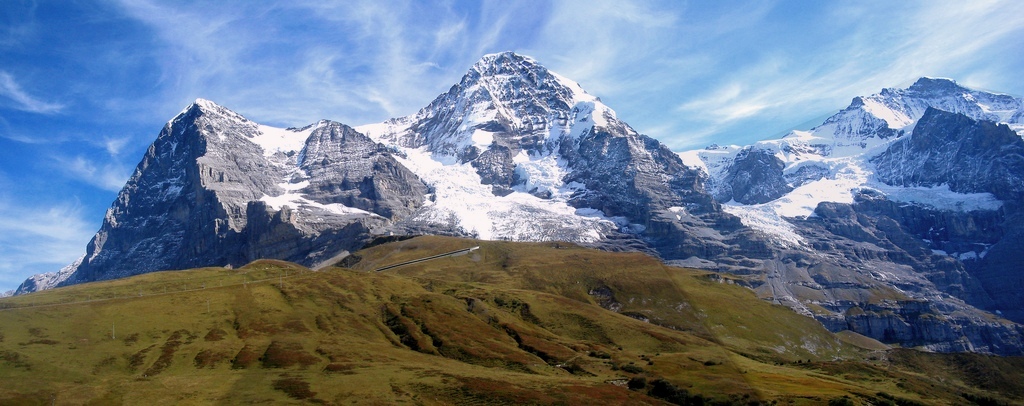
Jungfraujoch is the lowest point on the mountain ridge between Mönch and Jungfrau, at 3,471 meters (11,388 ft). It is just above this location that the mountain station of Jungfraubahn is located, Jungfraujoch railway station, which at an elevation of 3,454 meters (11,332 ft) is the highest railway station in Europe. The Jungfraujoch is often called the "Top of Europe" in tourist literature. Not far east of the Joch rises a peak called the Sphinx, which tops out at an elevation of 3,571 meters (11,716 ft). It begins from the Jungfraujoch on the Valais side and at the Great Aletsch Glacier. There is an elevator to the summit of the Sphinx, where a small viewing platform and a scientific observatory, the Sphinx Observatory, are located.

